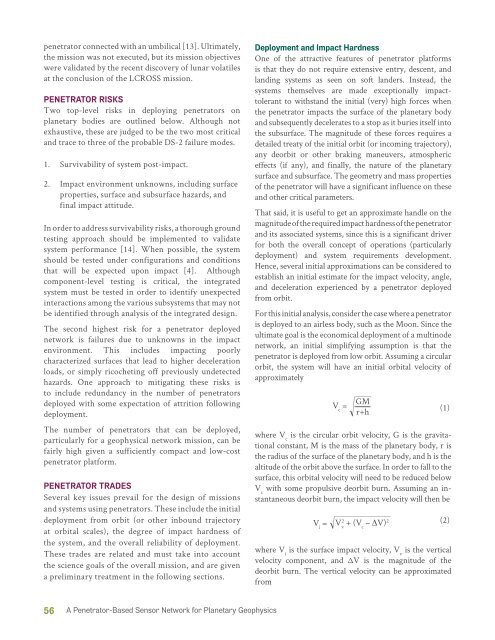The Draper Technology Digest - Draper Laboratory
The Draper Technology Digest - Draper Laboratory
The Draper Technology Digest - Draper Laboratory
You also want an ePaper? Increase the reach of your titles
YUMPU automatically turns print PDFs into web optimized ePapers that Google loves.
penetrator connected with an umbilical [13]. Ultimately,the mission was not executed, but its mission objectiveswere validated by the recent discovery of lunar volatilesat the conclusion of the LCROSS mission.PENETRATOR RISKSTwo top-level risks in deploying penetrators onplanetary bodies are outlined below. Although notexhaustive, these are judged to be the two most criticaland trace to three of the probable DS-2 failure modes.1. Survivability of system post-impact.2. Impact environment unknowns, including surfaceproperties, surface and subsurface hazards, andfinal impact attitude.In order to address survivability risks, a thorough groundtesting approach should be implemented to validatesystem performance [14]. When possible, the systemshould be tested under configurations and conditionsthat will be expected upon impact [4]. Althoughcomponent-level testing is critical, the integratedsystem must be tested in order to identify unexpectedinteractions among the various subsystems that may notbe identified through analysis of the integrated design.<strong>The</strong> second highest risk for a penetrator deployednetwork is failures due to unknowns in the impactenvironment. This includes impacting poorlycharacterized surfaces that lead to higher decelerationloads, or simply ricocheting off previously undetectedhazards. One approach to mitigating these risks isto include redundancy in the number of penetratorsdeployed with some expectation of attrition followingdeployment.<strong>The</strong> number of penetrators that can be deployed,particularly for a geophysical network mission, can befairly high given a sufficiently compact and low-costpenetrator platform.PENETRATOR TRADESSeveral key issues prevail for the design of missionsand systems using penetrators. <strong>The</strong>se include the initialdeployment from orbit (or other inbound trajectoryat orbital scales), the degree of impact hardness ofthe system, and the overall reliability of deployment.<strong>The</strong>se trades are related and must take into accountthe science goals of the overall mission, and are givena preliminary treatment in the following sections.Deployment and Impact HardnessOne of the attractive features of penetrator platformsis that they do not require extensive entry, descent, andlanding systems as seen on soft landers. Instead, thesystems themselves are made exceptionally impacttolerantto withstand the initial (very) high forces whenthe penetrator impacts the surface of the planetary bodyand subsequently decelerates to a stop as it buries itself intothe subsurface. <strong>The</strong> magnitude of these forces requires adetailed treaty of the initial orbit (or incoming trajectory),any deorbit or other braking maneuvers, atmosphericeffects (if any), and finally, the nature of the planetarysurface and subsurface. <strong>The</strong> geometry and mass propertiesof the penetrator will have a significant influence on theseand other critical parameters.That said, it is useful to get an approximate handle on themagnitude of the required impact hardness of the penetratorand its associated systems, since this is a significant driverfor both the overall concept of operations (particularlydeployment) and system requirements development.Hence, several initial approximations can be considered toestablish an initial estimate for the impact velocity, angle,and deceleration experienced by a penetrator deployedfrom orbit.For this initial analysis, consider the case where a penetratoris deployed to an airless body, such as the Moon. Since theultimate goal is the economical deployment of a multinodenetwork, an initial simplifying assumption is that thepenetrator is deployed from low orbit. Assuming a circularorbit, the system will have an initial orbital velocity ofapproximatelyVGMc=r+h(1)where V cis the circular orbit velocity, G is the gravitationalconstant, M is the mass of the planetary body, r isthe radius of the surface of the planetary body, and h is thealtitude of the orbit above the surface. In order to fall to thesurface, this orbital velocity will need to be reduced belowV cwith some propulsive deorbit burn. Assuming an instantaneousdeorbit burn, the impact velocity will then beV i=V v2+ (V c– V) 2where V iis the surface impact velocity, V vis the verticalvelocity component, and ∆V is the magnitude of thedeorbit burn. <strong>The</strong> vertical velocity can be approximatedfrom(2)56 A Penetrator-Based Sensor Network for Planetary Geophysics
















